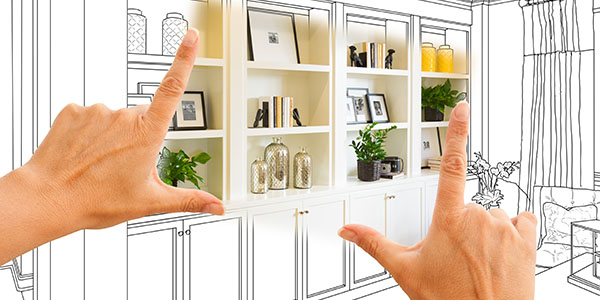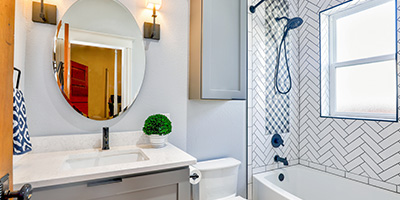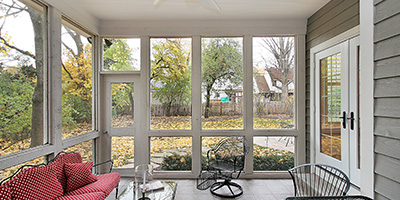DIY Hacks: 10 Little-Known Home Improvement Tips to Make Your Project Easier

10 DIY Tips to Improve Your Home
Even for the most diehard DIY-er, looking up DIY hacks on the internet can be frustrating. You’re looking for information on how to make a particular task, like framing a wall or finding a stud, easier or more efficient, but all the “hacks” you unearth are actually just suggestions for other projects you could try out. Well, if you’re looking for real home improvement tips that can help you conquer your next remodeling project, we’ve got the DIY hacks you’ve been waiting for.
#1: Find a Stud Without a Stud Finder
You might be familiar with the “tap” method of stud-finding, where you knock on the wall listening for the solid sound of a stud as opposed to the hollow sound of the rest of the wall. If you’re just knocking around blindly, this method is pretty hit or miss. However, this method works very well when combined with some basic knowledge about studs. Studs are generally uniformly spaced throughout your walls. Today, the standard is 16 inches apart—but some homes, especially if they’re older, may have studs that are 12 or 24 inches apart.
To use this stud-finding method, mark the general spot on your wall where you want to hang something. From a corner of the room, use a measuring tape to mark 12, 16, and 24 inches from the corner. Next, tap at each point; compare the sounds you hear and when you’ve found the one that sounds solid, you’ve found a stud! Now all you need to do is continue measuring using the appropriate increment (12, 16, or 24, depending on where you heard the solid sound) until you find the stud closest to where you wanted to hang your item.
#2: Rent a Dumpster
Whether you’re taking on an ambitious construction project or just decluttering your garage, by the time the project’s complete you’re going to be left with plenty of garbage. Bagging it all up is time consuming, and since keeping your work area clear is generally necessary for getting the job done efficiently, it can eat up lots of valuable work time.
A dumpster rental can save you time and money on all but the smallest home improvement projects. And it’s easy to find a dumpster size appropriate for the job: roll-off containers come in 10 yard sizes suited for general decluttering or a small scale remodeling project, all the way to up to 40 yard dumpsters capable of holding the equivalent of 12 truckloads of waste. Depending on your project and space you have available, you can even opt to have your dumpster placed under a window in the room where you’ll be working, making your cleanup even easier.
#3: Optimize Drying Times
Waiting for paint, joint compound, or other common materials to dry so that you can move on to the next step of your project is one of the most frustrating aspects of remodeling. Luckily, there are plenty of home improvement tips to shorten drying times.
First, if the weather permits, simply open the windows. Fresh, circulating air is key to making anything dry faster.Obviously, you can also use oscillating fans for this, but if you don’t have any on hand, a simple open window does the trick.
To make paint dry faster, a couple of preemptive measures can serve you well. Choose a zero-VOC paint, and paint with foam brushes or rollers. Foam absorbs less paint than other materials, allowing you to apply a thinner (and thus quicker-drying) layer to the wall or object you’re painting.
Another great painting hack is to paint only one wall of a room at a time, rather than having multiple helpers paint everything at once. This way, the first wall will be dry, or nearly dry, by the time you finish the fourth wall, vastly cutting down the time you need to wait between coats.
If you need a quicker way to dry joint compound while you’re patching drywall, you can use a hair dryer, moving it rapidly back and forth about 2-4 inches from the compound. If the area you need to dry is too large for a hair dryer, you can set up a space heater several feet from the area.
#4: Clean Chandeliers and Other Awkward Items
Intricate lighting fixtures or decorative items constantly pose a problem when it’s time to spruce things up. It’s tough to maneuver a duster or dust cloth into the nooks and crannies, but gloves can get you around these difficulties.
Put on a pair of white cotton gloves and simply run your hands over the items in question. Being able to grasp the contours of intricate items makes the process much simpler and more effective. If you need to use a cleaning solution on a particular item, you can spray the cleaner on one of your gloves, and use your other gloved hand to dry.
Not sure where to start when it comes to remodeling your home? Check out our Home Renovation Guide!
#5: Lay Tile Straight and Keep Pattern Intact
People may try to tell you that amateurs can’t lay tile. That you have to hire a professional or your tile can’t possibly come out straight or in the right pattern. That would be true, if it wasn’t for this awesomely simple DIY hack.
Make a layout board to lay tiles straight and in the correct pattern:
Once you’ve decided on the pattern you want for your tiles and how much space to leave between by dry fitting them on the wall in question, lay them out on the floor in the correct pattern and with the correct distance between them.
Take a straight, level pieces of board and place it under the row of tile. Using a permanent marker, mark on the board where each tile should slot in. Within each slot, write what color tile should go there. If you’ll be laying different patterns in different rows, make a separate layout board for each pattern.
Nail the layout board beneath where the first row of tiles will go so that the bottom of the tiles will rest against the board. Use a level to ensure it’s straight. Once you’ve spread your mortar, you’ll just line up each tile with its spot on the layout board. Simply move the board down, and/or swap in your other boards, as you lay additional rows.
#6: Leave No Nails Behind
You’ve finished a remodeling project, you’ve done the cleanup (maybe renting a dumpster to make it easier!), but when it comes to the tiny debris like nails and screws, it’s hard to be sure you got them all. Especially if you have young children or pets in the house, you obviously want to be sure there aren’t nails or other bits of metal lying around. If you have a large magnet on hand, sweep it around your work area to pick up stray metal. If not, you can rent a magnetic broom from many hardware or home improvement stores and use it the same way.

#7: Easily Visualize a New Layout
When you want to change the layout of a room, especially if you’ll be doing so by adding walls or other architectural elements, it can be difficult to visualize on paper what the final product will look like, which in turn makes it difficult to know whether your desired layout will really work in the space.
A simple way to test out possible new layouts for a space “in real life” involves nothing more than a handful of nails or tacks and some string. Simply use the string to sketch out the outline of your proposed layout, securing it to nails/tacks as necessary. When you settle on a layout that works, all you need to do is measure the strings to get the dimensions!
#8: Rent Instead of Buy
Unless you’re a professional or an extreme DIY junkie, there are a huge number of tools that you’ll only ever need to use on occasion. In fact, for most of us this applies to the majority of tools beyond the basics. Unfortunately, many people don’t realize just how many tools can be rented rather than purchased. This applies both to very specialized tools and to more general items like chain saws, masonry drills, and stud guns. All of these tools and more can almost certainly be rented from your preferred home improvement store. Renting these tools is almost always more economical than buying them, not to mention the added convenience of not needing to make room in your garage to store them.
#9: Space Studs 16 Inches on Center
If you’re constructing new walls (whether to build a walk-in closet or partition off a portion of a room) then it’s essential that your wall studs be positioned “16 inches on center,” meaning that the center of each stud is spaced 16 inches away from the center of the next stud. This is currently the standard measurement for stud spacing, and drywall, cabinetry, and other building materials are made to fit this framework. For those of us who aren’t pros, getting stud alignment right can be tricky. There are other methods out there that might suit those with more carpentry experience, but for the beginning DIY-er, here’s Bob Schmidt of Home Remodel Workshop’s fool-proof method for framing walls that are 16 inches on center:
Cut two 2X4s to the length of the wall you want to build. These will be your header and footer plates. Lay out your plates, one above the other, and stretch a tape measure across their full length.
Most tape measures have red markings indicating where studs should be placed when framing a wall. Wherever you see these marks, use a permanent marker to make an X three quarter inches back from the mark, on both boards.
Once you have done this down the full length of each board, place the thin side of a framing square over the first X on both boards, and draw a line across both boards on either side of the framing square. Repeat for all of your Xs. The thin side of a framing square is the same width as a stud, so when it comes time to nail in your studs, they will slot right between these lines, giving you a wall framed perfectly 16 inches on center.
#10: Find a Leak
Left unchecked, even a relatively minor leak can wreak havoc over time. With so many different things in your home that can leak–sinks, tubs, showers, toilets, water heaters, the pipes inside your walls–the source isn’t always obvious, but just about any leak, whatever the source, can be identified with practically no effort—and no tools!
The tell-tale signs of any leak are stains or buckling/warping of the floor around them. This is often easiest to spot by looking at the floor in question from below—whether that’s the basement or a lower floor of your home. So, if you think you have a leak, simply walk your house floor by floor, looking for stains or buckling on the ceiling. If you find such a spot, trace it up to the next floor and find the water source closest to it. This is likely to be the cause of your leak.
If you can’t identify a source for your suspected leak, then it is likely coming from the plumbing inside your walls. To test for this, close the shut off valves for all water sources in your home. Then go to your water meter and mark the position of the “1 cubic foot” dial. Wait an hour and check the dial again. If the dial has moved, you have a leak in your water supply lines.



